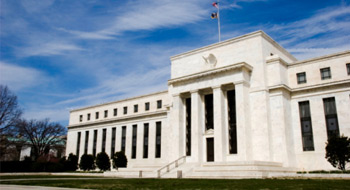

There was no mention of a third round of quantitative easing, but the Federal Open Market Committee has announced it will leave interest rates near zero until at least mid-2013.
The Federal Reserve has held rates at just 25 basis points since December 2008. Until today, the Fed had said it would keep it low for “an extended period.”
The more explicit time frame is aimed at calming nervous investors, giving them a clearer picture of how long they will be able to obtain ultra-cheap credit.
“Economic growth so far this year has been considerably slower than the committee had expected,” the Fed admitted in its press release, predicting a “somewhat slower pace of recovery over coming quarters.”
The shift in language was as mild a form of stimulus as the Fed could provide. There had been some hope in the market that a third round of quantitative easing would be launched.
“There had been rumours that they would do something beyond the earlier pledge to keep rates low for ‘an extended period’—after all, [Ben] Bernanke had indicated that ‘extended’ only meant two or three months,” said Peter Buchanan, senior economist at CIBC World Markets.
“The market is a bit disappointed, as some people had thought that they might leap straight ahead with another round of quantitative easing, and they decided not to do that,” he said.
“The economic wording was a good deal more cautious than in the previous statement,” he said. “They noted that while growth has moderated, only part of that slowdown is due to transitory factors. The subtext is that the Fed is more worried about the outlook than it was a month or two ago.”
“There weren’t the sort of hints [regarding another round of quantitative easing] there that some people were hoping for, so that’s why we’ve had the pullback in equities as well as in the price of oil and other commodities,” Buchanan said.
“By adopting a definitely more dovish tone and announcing that it planned to keep its key interest rate exceptionally low for nearly two years, the U.S. monetary authorities are clearly showing that they take the current situation seriously,” wrote Mathieu D’Anjou, senior economist, Desjardins Financial Security. “The fact that the Fed is announcing plans to keep its key interest rate exceptionally low until at least mid-2013 reflects major concerns about the economic recovery in the United States. If economic outlooks go on deteriorating and the panic in the financial markets continues, the Fed will quickly take more direct action, possibly including new quantitative measures.”
“The Fed does not seem to foresee another recession, but it will certainly revise its growth scenario downwards, and notes an increase in downside risks,” D’Anjou wrote. “On the other hand, it is not very concerned about inflation, and attributes the acceleration observed since the start of 2011 to temporary factors that now seem to have faded somewhat.”
In Canada, Buchanan said the Bank of Canada will likely leave its key policy rate at 1% until early 2012.
“The Fed’s conditional commitment is not that dissimilar to what the Bank of Canada said a year or so ago,” Buchanan said. “I think the Bank is under reduced pressure [to raise rates], as a result of the market turmoil. This would certainly nudge it further in that direction.”
Michael Gapen, director of U.S. economic research at Barclays Capital, drew a parallel to actions taken by the Bank of Canada in April 2009, suggesting the Fed’s goal is to influence longer-term interest rates. In this regard, he said the announcement came as no surprise.
“Given that the Fed has stated that a removal of the reinvestment policy would likely be a first step in any exit strategy, [Tuesday’s] decision also suggests that the size of the balance sheet could remain constant into late 2012 or beyond,” Gapen said. “The statement also clearly leaves the door open for further asset purchases, or QE3.”
He also pointed out that three of the Fed’s regional presidents dissented from the announcement, preferring to stock with “extended period” rather than giving a timeline. This, Gapen said, hints at future dissent if the Fed decides to resume asset purchases under a third round of quantitative easing.
